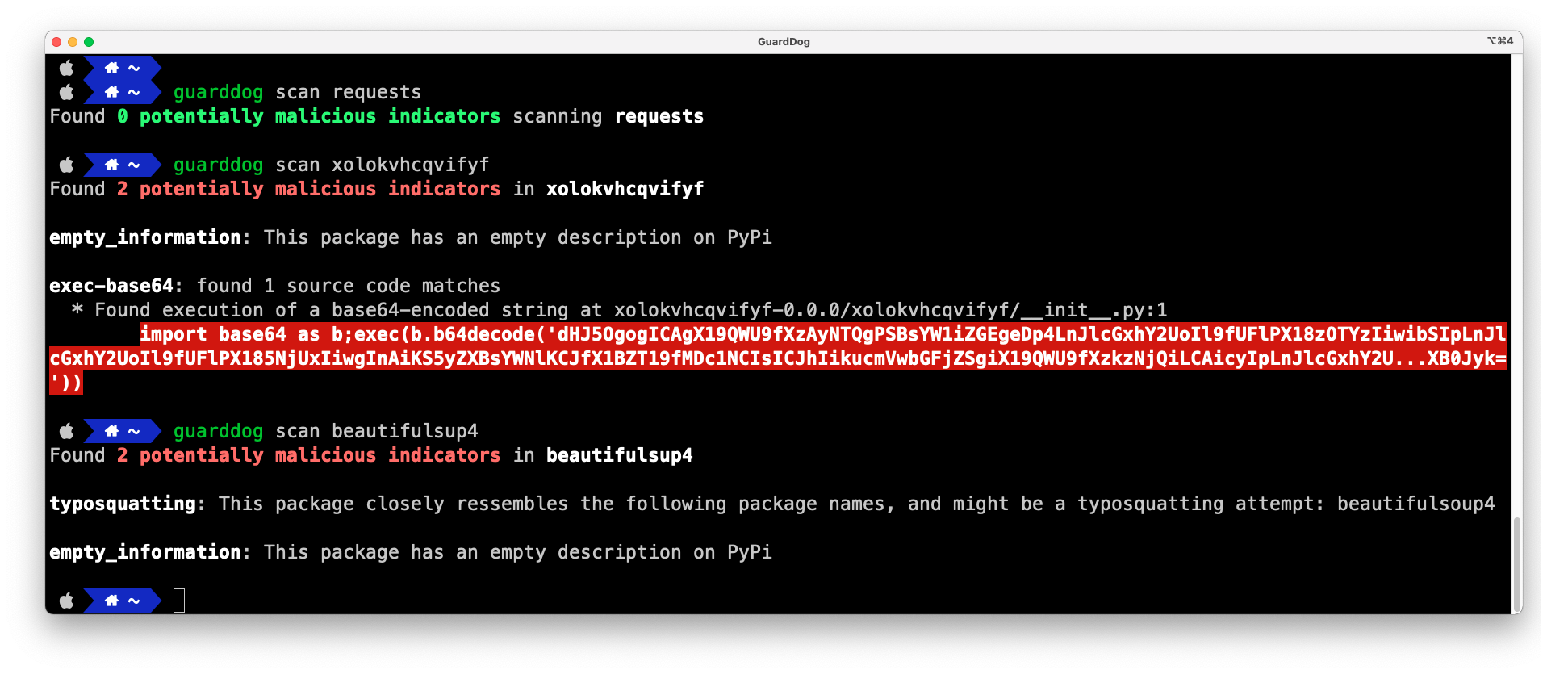GuardDog

GuardDog 是一个命令行工具,用于识别恶意的 PyPI 和 npm 包或 Go 模块。它通过 Semgrep 规则对包的源代码和元数据运行一系列启发式检查。
GuardDog 可以使用任何可用的启发式方法来扫描本地或远程的 PyPI 和 npm 包或 Go 模块。

入门
安装
pip install guarddog
或使用 Docker 镜像:
docker pull ghcr.io/datadog/guarddog
alias guarddog='docker run --rm ghcr.io/datadog/guarddog'
注意:在 Windows 上,唯一支持的安装方法是 Docker。
示例用法
# 扫描 'requests' 包的最新版本
guarddog pypi scan requests
# 扫描 'requests' 包的特定版本
guarddog pypi scan requests --version 2.28.1
# 使用 2 个特定的启发式方法扫描 'request' 包
guarddog pypi scan requests --rules exec-base64 --rules code-execution
# 使用除一个规则外的所有规则扫描 'requests' 包
guarddog pypi scan requests --exclude-rules exec-base64
# 扫描本地包归档
guarddog pypi scan /tmp/triage.tar.gz
# 扫描本地包目录
guarddog pypi scan /tmp/triage/
# 扫描本地文件夹中 requirements.txt 文件引用的每个包
guarddog pypi verify workspace/guarddog/requirements.txt
# 扫描 requirements.txt 文件引用的每个包并输出 sarif 文件 - 仅适用于 verify 命令
guarddog pypi verify --output-format=sarif workspace/guarddog/requirements.txt
# 将 JSON 输出到标准输出 - 适用于每个命令
guarddog pypi scan requests --output-format=json
# 所有命令也适用于 npm 或 go
guarddog npm scan express
# 以调试模式运行
guarddog --log-level debug npm scan express
启发式方法
GuardDog 包含两种类型的启发式方法:
PyPI
源代码启发式方法:
| 启发式方法 | 描述 |
|---|---|
| shady-links | 识别包中是否包含指向可疑域名扩展的 URL |
| obfuscation | 识别包是否使用恶意软件常用的混淆方法 |
| clipboard-access | 识别包是否读取或写入剪贴板数据 |
| exfiltrate-sensitive-data | 识别包是否从本地系统读取并泄露敏感数据 |
| download-executable | 识别包是否下载并执行远程二进制文件 |
| exec-base64 | 识别包是否动态执行 base64 编码的代码 |
| silent-process-execution | 识别包是否静默执行可执行文件 |
| dll-hijacking | 识别恶意包是否操纵受信任的应用程序加载恶意 DLL |
| bidirectional-characters | 识别包是否包含双向字符,这可能被用来显示与实际执行不同的源代码。更多信息请参见 https://trojansource.codes/ |
| steganography | 识别包是否从图像中检索隐藏数据并执行 |
| code-execution | 识别 setup.py 文件中是否执行操作系统命令 |
| cmd-overwrite | 识别 setup.py 中的 'install' 命令是否被覆盖,表明在安装包时自动运行的代码 |
元数据启发式方法:
| 启发式方法 | 描述 |
|---|---|
| empty_information | 识别描述字段为空的包 |
| release_zero | 识别发布版本为 0.0 或 0.0.0 的包 |
| typosquatting | 识别与高度流行的包名称相近的包 |
| potentially_compromised_email_domain | 识别包维护者的电子邮件域名(因此包管理器账户)可能已被入侵 |
| unclaimed_maintainer_email_domain | 识别包维护者的电子邮件域名(因此 npm 账户)未被认领且可被攻击者注册 |
| repository_integrity_mismatch | 识别链接的 GitHub 仓库中包含额外意外文件的包 |
| single_python_file | 识别只有单个 Python 文件的包 |
| bundled_binary | 识别捆绑二进制文件的包 |
| deceptive_author | 此启发式方法检测作者是否使用一次性电子邮件 |
npm
源代码启发式方法:
| 启发式方法 | 描述 |
|---|---|
| npm-serialize-environment | 识别包是否序列化 'process.env' 以泄露环境变量 |
| npm-obfuscation | 识别包是否使用恶意软件常用的混淆方法 |
| npm-silent-process-execution | 识别包是否静默执行可执行文件 |
| shady-links | 识别包中是否包含指向可疑域名扩展的 URL |
| npm-exec-base64 | 识别包是否通过 'eval' 动态执行代码 |
| npm-install-script | 识别包是否有自动运行命令的预安装或后安装脚本 |
| npm-steganography | 识别包是否从图像中检索隐藏数据并执行 |
| bidirectional-characters | 识别包是否包含双向字符,这可能被用来显示与实际执行不同的源代码。更多信息请参见 https://trojansource.codes/ |
| npm-dll-hijacking | 识别恶意包是否操纵受信任的应用程序加载恶意 DLL |
| npm-exfiltrate-sensitive-data | 识别包是否从本地系统读取并泄露敏感数据 |
元数据启发式方法:
| 启发式方法 | 描述 |
|---|---|
| empty_information | 识别描述字段为空的包 |
| release_zero | 识别发布版本为 0.0 或 0.0.0 的包 |
| potentially_compromised_email_domain | 识别包维护者的电子邮件域名(因此包管理器账户)可能已被入侵;注意,NPM 的 API 可能不提供关于维护者电子邮件的准确信息,因此这个检测器可能会对 NPM 包造成误报。参见 https://www.theregister.com/2022/05/10/security_npm_email/ |
| unclaimed_maintainer_email_domain | 识别包维护者的电子邮件域名(因此 npm 账户)未被认领且可被攻击者注册;注意,NPM 的 API 可能不提供关于维护者电子邮件的准确信息,因此这个检测器可能会对 NPM 包造成误报。参见 https://www.theregister.com/2022/05/10/security_npm_email/ |
| typosquatting | 识别与高度流行的包名称相近的包 |
| direct_url_dependency | 识别具有直接 URL 依赖的包。通过这种方式获取的依赖项不是不可变的,可能被用来注入不可信的代码或降低可重现安装的可能性。 |
| npm_metadata_mismatch | 识别 npm 包清单和包信息在某些关键字段上存在不匹配的包 |
| bundled_binary | 识别捆绑二进制文件的包 |
| deceptive_author | 此启发式方法检测作者是否使用一次性电子邮件 |
go
源代码启发式方法:
| 启发式方法 | 描述 |
|---|---|
| shady-links | 识别包中是否包含指向可疑域名扩展的 URL |
自定义规则
Guarddog 允许实现自定义源代码规则。 源代码规则位于 guarddog/analyzer/sourcecode 目录下,支持的格式是 Semgrep 或 Yara。
- Semgrep 规则是与语言相关的,Guarddog 将导入所有与用户在 CLI 中选择的生态系统语言匹配的
.yml规则。 - 另一方面,Yara 规则与语言无关,因此所有匹配的
.yar规则都会被导入。
您可以编写自己的规则并将其放入该目录,Guarddog 将允许您像选择或排除任何内置规则一样选择或排除它,并将结果附加到输出中。 例如,您可以创建以下 semgrep 规则:
rules:
- id: sample-rule
languages:
- python
message: 规则匹配时的输出信息
metadata:
description: CLI 帮助中使用的描述
patterns:
在此处添加您的规则启发式
severity: WARNING
然后您需要将其保存为 sample-rule.yml,并注意 id 必须与文件名匹配。
对于 Yara,您可以创建以下规则:
rule sample-rule
{
meta:
description = "输出信息中使用的描述"
target_entity = "file"
strings:
$exec = "exec"
condition:
1 of them
}
然后您需要将其保存为 sample-rule.yar。
请注意,在这两种情况下,规则 id 都必须与文件名匹配。
在 GitHub Action 中运行 GuardDog
将 GuardDog 集成到您的 CI 流程中最简单的方法是利用 SARIF 输出格式,并将其上传到 GitHub 的代码扫描功能。
使用这种方法,您可以获得:
- 基于 GuardDog 扫描输出的自动 pull request 评论
- 直接在 GitHub UI 中内置的误报管理
使用 GuardDog 的示例 GitHub Action:
name: GuardDog
on:
push:
branches:
- main
pull_request:
branches:
- main
permissions:
contents: read
jobs:
guarddog:
permissions:
contents: read # 用于 actions/checkout 获取代码
security-events: write # 用于 github/codeql-action/upload-sarif 上传 SARIF 结果
name: 扫描依赖项
runs-on: ubuntu-latest
steps:
- uses: actions/checkout@v4
- name: 设置 Python
uses: actions/setup-python@v5
with:
python-version: "3.10"
- name: 安装 GuardDog
run: pip install guarddog
- run: guarddog pypi verify requirements.txt --output-format sarif --exclude-rules repository_integrity_mismatch > guarddog.sarif
- name: 将 SARIF 文件上传到 GitHub
uses: github/codeql-action/upload-sarif@v3
with:
category: guarddog-builtin
sarif_file: guarddog.sarif
开发
运行 GuardDog 的本地版本
使用 pip
- 确保已安装
>=python3.10 - 克隆仓库
- 创建虚拟环境:
python3 -m venv venv && source venv/bin/activate - 安装依赖:
pip install -r requirements.txt - 使用
python -m guarddog运行 GuardDog
使用 poetry
- 确保 poetry 有一个
python >=3.10的环境poetry env use 3.10.0 - 安装依赖
poetry install - 运行 guarddog
poetry run guarddog或poetry shell然后运行guarddog
单元测试
运行所有单元测试:make test
运行针对 Semgrep 规则的单元测试:make test-semgrep-rules(测试在这里)。这些测试使用测试 Semgrep 规则的标准方法。
运行针对包元数据启发式的单元测试:make test-metadata-rules(测试在这里)。
基准测试
您可以在合法和恶意包上运行 GuardDog 来确定误报和漏报。请参见 ./tests/samples
代码质量检查
运行类型检查器:
mypy --install-types --non-interactive guarddog
运行代码风格检查器:
flake8 guarddog --count --select=E9,F63,F7,F82 --show-source --statistics --exclude tests/analyzer/sourcecode,tests/analyzer/metadata/resources,evaluator/data
flake8 guarddog --count --max-line-length=120 --statistics --exclude tests/analyzer/sourcecode,tests/analyzer/metadata/resources,evaluator/data --ignore=E203,W503
维护者
作者:
致谢
灵感来源:
- Backstabber's Knife Collection: A Review of Open Source Software Supply Chain Attacks
- What are Weak Links in the npm Supply Chain?
- A Survey on Common Threats in npm and PyPi Registries
- A Benchmark Comparison of Python Malware Detection Approaches
- Towards Measuring Supply Chain Attacks on Package Managers for Interpreted Languages

 访问官网
访问官网 Github
Github 文档
文档 论文
论文










